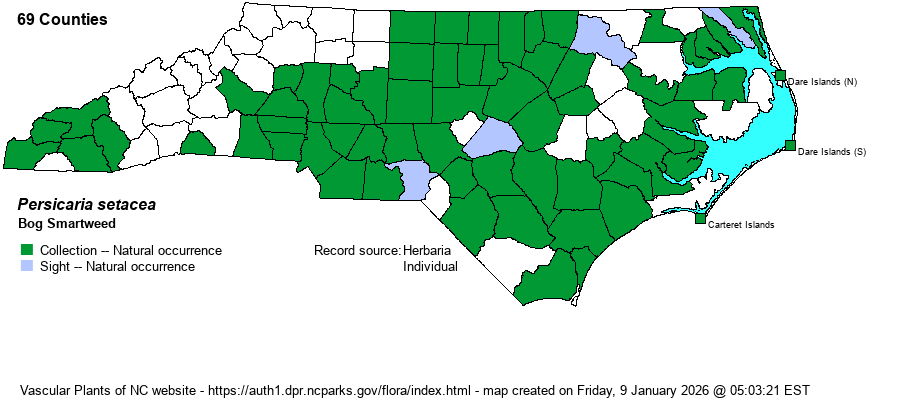| Author | (Baldwin) Small | |
| Distribution | Throughout most of the state, but apparently absent from the central and northern Mountains and the northwestern Piedmont.
MA to MI, MO, and OK, south to FL and TX. | |
| Abundance | Fairly common in most of the Coastal Plain and Piedmont, rare in the southern Mountains, and probably absent in the northwestern part of the state. Oddly infrequent in the northern Coastal Plain, considering that it has been collected in all southeastern VA counties -- likely a sign of overlooking it there. | |
| Habitat | Wet bottomlands and floodplain forests, oxbow ponds, swamp forests, maritime swamp forests, interdune marshes. More of a swamp and bottomland species than others in the genus, not often in disturbed wet ground nor in very open marshes. |
| Phenology | Flowering and fruiting July-November. | |
| Identification | Bog Smartweed is one of several of our species which look similar in the field: erect stems 2-4 feet, with inflorescences terminal and from upper leaf axils. In this species, the flowers are green and white and showy (not pink or rosy), ocreae bristles are greater than 0.5 mm long, and sepals are smooth (not pitted or punctate). Swamp Smartweed (P. hydropiperoides) is usually shorter, narrow-leaved (usually less than 1/2-inch wide), thinner-stemmed, and flowers not as bright white. Dotted Smartweed (P. punctata) is also smaller and narrower-leaved, with a slender and often leaning stem, has definite pits on sepals (vs. none), and has flowering spikes with many large gaps between flowers. Bog Smartweed is a rather showy smartweed, with a rather densely flowered spike of white flowers, the spike with few gaps between flowers, and rather straight spikes, not strongly curved or arcing as in several species. This species is often overlooked and passed over as another species; it is not nearly as common in much of the state as most other white-flowered species -- P. punctata, P. hydropiperoides, and P. lapathifolia. Oftentimes, it is identified by default, though it is a "horsier" plant, with a thicker stem and wider leaves (often 1 inch or wider). | |
| Taxonomic Comments | Formerly named as Polygonum setaceum in many references. Some had it as a variety of P. hydropiperoides, as var. setaceum.
Many species formerly treated in the genus Polygonum have been moved to Persicaria, the smartweeds. These are generally erect and tall plants with terminal and axillary floral spikes; most occur in wetlands. Others remain in Polygonum, the knotweeds, which are generally prostrate to ascending and with inconspicuous axillary flowers. They occur mostly in dry soils and tend to be weedy.
Attention must be paid to the small collars at the junction of the main stem and leaf stems (called ocreae) and whether they possess terminal hairs or bristles. Some keys also refer to the even smaller collars from which flowers emerge (called ocreolae). Another important ID character is the surface of the greenish sepals -- whether smooth or dotted with indentations (punctate). | |
| Other Common Name(s) | Bristly Smartweed, Swamp Smartweed (used now for P. hydropiperoides) | |
| State Rank | S5 | |
| Global Rank | G5 | |
| State Status | | |
| US Status | | |
| USACE-agcp | OBL link |
| USACE-emp | OBL link |

